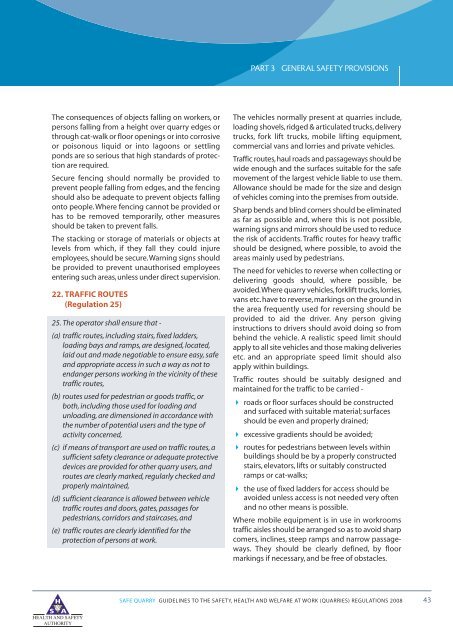Safe Quarry - Health and Safety Authority
Safe Quarry - Health and Safety Authority
Safe Quarry - Health and Safety Authority
You also want an ePaper? Increase the reach of your titles
YUMPU automatically turns print PDFs into web optimized ePapers that Google loves.
PART 3<br />
GENERAL SAFETY PROVISIONS<br />
The consequences of objects falling on workers, or<br />
persons falling from a height over quarry edges or<br />
through cat-walk or floor openings or into corrosive<br />
or poisonous liquid or into lagoons or settling<br />
ponds are so serious that high st<strong>and</strong>ards of protection<br />
are required.<br />
Secure fencing should normally be provided to<br />
prevent people falling from edges, <strong>and</strong> the fencing<br />
should also be adequate to prevent objects falling<br />
onto people. Where fencing cannot be provided or<br />
has to be removed temporarily, other measures<br />
should be taken to prevent falls.<br />
The stacking or storage of materials or objects at<br />
levels from which, if they fall they could injure<br />
employees, should be secure.Warning signs should<br />
be provided to prevent unauthorised employees<br />
entering such areas,unless under direct supervision.<br />
22. TRAFFIC ROUTES<br />
(Regulation 25)<br />
25. The operator shall ensure that -<br />
(a) traffic routes, including stairs, fixed ladders,<br />
loading bays <strong>and</strong> ramps, are designed, located,<br />
laid out <strong>and</strong> made negotiable to ensure easy, safe<br />
<strong>and</strong> appropriate access in such a way as not to<br />
endanger persons working in the vicinity of these<br />
traffic routes,<br />
(b) routes used for pedestrian or goods traffic, or<br />
both, including those used for loading <strong>and</strong><br />
unloading, are dimensioned in accordance with<br />
the number of potential users <strong>and</strong> the type of<br />
activity concerned,<br />
(c) if means of transport are used on traffic routes, a<br />
sufficient safety clearance or adequate protective<br />
devices are provided for other quarry users, <strong>and</strong><br />
routes are clearly marked, regularly checked <strong>and</strong><br />
properly maintained,<br />
(d) sufficient clearance is allowed between vehicle<br />
traffic routes <strong>and</strong> doors, gates, passages for<br />
pedestrians, corridors <strong>and</strong> staircases, <strong>and</strong><br />
(e) traffic routes are clearly identified for the<br />
protection of persons at work.<br />
The vehicles normally present at quarries include,<br />
loading shovels, ridged & articulated trucks, delivery<br />
trucks, fork lift trucks, mobile lifting equipment,<br />
commercial vans <strong>and</strong> lorries <strong>and</strong> private vehicles.<br />
Traffic routes,haul roads <strong>and</strong> passageways should be<br />
wide enough <strong>and</strong> the surfaces suitable for the safe<br />
movement of the largest vehicle liable to use them.<br />
Allowance should be made for the size <strong>and</strong> design<br />
of vehicles coming into the premises from outside.<br />
Sharp bends <strong>and</strong> blind corners should be eliminated<br />
as far as possible <strong>and</strong>, where this is not possible,<br />
warning signs <strong>and</strong> mirrors should be used to reduce<br />
the risk of accidents. Traffic routes for heavy traffic<br />
should be designed, where possible, to avoid the<br />
areas mainly used by pedestrians.<br />
The need for vehicles to reverse when collecting or<br />
delivering goods should, where possible, be<br />
avoided.Where quarry vehicles,forklift trucks,lorries,<br />
vans etc.have to reverse, markings on the ground in<br />
the area frequently used for reversing should be<br />
provided to aid the driver. Any person giving<br />
instructions to drivers should avoid doing so from<br />
behind the vehicle. A realistic speed limit should<br />
apply to all site vehicles <strong>and</strong> those making deliveries<br />
etc. <strong>and</strong> an appropriate speed limit should also<br />
apply within buildings.<br />
Traffic routes should be suitably designed <strong>and</strong><br />
maintained for the traffic to be carried -<br />
roads or floor surfaces should be constructed<br />
<strong>and</strong> surfaced with suitable material; surfaces<br />
should be even <strong>and</strong> properly drained;<br />
excessive gradients should be avoided;<br />
routes for pedestrians between levels within<br />
buildings should be by a properly constructed<br />
stairs, elevators, lifts or suitably constructed<br />
ramps or cat-walks;<br />
the use of fixed ladders for access should be<br />
avoided unless access is not needed very often<br />
<strong>and</strong> no other means is possible.<br />
Where mobile equipment is in use in workrooms<br />
traffic aisles should be arranged so as to avoid sharp<br />
comers, inclines, steep ramps <strong>and</strong> narrow passageways.<br />
They should be clearly defined, by floor<br />
markings if necessary, <strong>and</strong> be free of obstacles.<br />
SAFE QUARRY GUIDELINES TO THE SAFETY, HEALTH AND WELFARE AT WORK (QUARRIES) REGULATIONS 2008 43
















